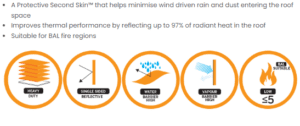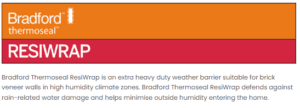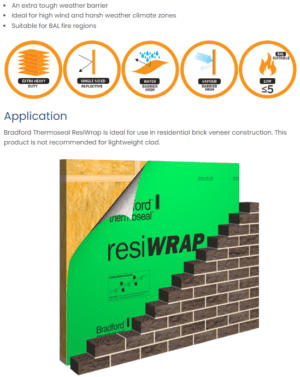Sarking
Protect your property from rain, dust and bushfire embers – all while boosting thermal insulation.
Renovating or building a new home? Sarking will improve its roof’s overall performance. This pliable laminated membrane provides vital protection against the elements, shielding your roof space from harsh weather and fire, regulating inside temperatures and minimising the risk of moisture damage.
At Insulation Industries, we are experts in all things roof sarking. Whether it’s to serve as thermal insulation, a barrier against bushfire embers or an extra layer of condensation control, we have a strong and cost-effective solution.
Explore our range of CSR Bradford sarking products online and request a quote. Australia-wide delivery available.
Discover the advantages of roof sarking
Our sarking brings a range of benefits both before and after roof construction.
Ward off water damage
Shelter the building’s internal structure from the elements before its roof is installed.
Accelerate construction
Provide the cover required for certain internal trades to start tasks in the absence of a roof.
Increase energy efficiency
Bolster thermal regulation and stay comfortable with insulated sarking that reflects up to 97% of radiant heat.
Prevent condensation & mould
Reduce the risk of condensation, ceiling stains and mould with sarking material that acts as a vapour barrier.
Minimise dust
Stop draughts from blowing dust into the roof space via gaps around downlights and vents.
Add fire protection
Living in a bushfire-prone area? Meet BAL (Bushfire Attack Level) requirements with a secondary layer of ember protection.
How to select the right sarking for your roof
When choosing roof sarking, it’s important to understand that it varies in reflective properties and vapour permeability. Reflective properties determine the degree of thermal insulation, while vapour permeability refers to the amount of moisture that can pass through.
The right reflective and permeability qualities for your sarking depend on the climate and whether you have a metal or tiled roof.
Local climate
The weather has a major influence on the type of roof sarking your home needs. For example, if you live in an area with hot, dry summers and mild winters, then non-permeable, foil sarking might work best.
On the other hand, homes in a region with mild summers and cold, wet winters, vapour permeable roof sarking may be more suitable.
Roof type
Tile roofs tend to require lightweight, breathable and durable sarking installed between the battens and rafters. This facilitates airflow between the roof cavity and outside, helping to prevent condensation.
Meanwhile, metal roof sarking ranges from thick, heavy-duty insulation options to thinner sheets that serve to protect against rain. This extra layer is ideal if living in a loud area, as it can also support acoustic insulation.
FAQs
What is roof sarking?
Sarking is a flexible sheet membrane that is usually fitted beneath the battens of tiled and metal roofs. Serving as a protective second skin, it helps to keep dust, moisture and draughts out of your home.
Sarking also tends to feature an aluminium foil layer that reflects the sun’s radiant heat away from your roof cavity, in turn improving thermal insulation throughout the building.
This waterproof barrier is typically installed during roof construction but can be retrofitted in certain circumstances.
What is sarking used for?
Sarking is primarily used to help keep your home dry and comfortable all year round. Offering cost-effective roofing insulation, it fills any gaps in the outer layer to prevent heat transfer and condensation issues.
It also blocks dust, fire embers and rain from entering the roof cavity through these gaps, channelling any water into the gutters.
Is roof sarking worth it?
Yes. Roof sarking is practically always worth the investment. Improving thermal regulation, energy efficiency, and weather protection, this extra layer is a key component of any building’s construction.
Without sarking in place to control condensation and water damage, you could face consequences like:
- Health hazards: Hidden mould growth behind walls, ceiling linings and cladding can pose serious health risks to residents.
- Aesthetic damage: Moisture accumulation behind plasterboard linings can lead to unsightly stains and bulging – which isn’t a great look for your plasterboard.
- Structural deterioration: If the building’s structure retains moisture, it can cause serious decay, such as metal corrosion, timber rot, and loose nails, which demand costly repairs.
- Reduced energy efficiency: The building’s energy efficiency may decline if insulation becomes saturated with moisture, leading to poor thermal performance.
Will roof sarking insulation increase the R-value of my home?
Yes. R-value indicates the insulation’s efficacy in resisting heat transfer. Put simply, a higher R-value means better insulation. Sarking is a type of insulation that can boost your home’s overall R-value if correctly installed over gaps in a roof.
It’s important to note that sarking’s ability to insulate varies based on its exact application, placement, and installation.
To provide sufficient thermal insulation for your roof cavity, it is usually paired with bulk insulation materials like glass wool or polyester batts, which are placed between the ceiling joists.
Is roof sarking mandatory?
Under the Building Code of Australia, sarking may be mandatory depending on factors such as:
- Local wind speed
- Terrain category
- Roof pitch – pitches under 20° must have sarking
- Rafter length – those over 6 metres long require sarking
- Bushfire Attack Level (BAL) – sarking is necessary on roofs in all BAL 12.5 to 40 rated areas to meet Australian Standard 3959
To ensure you’re abiding by all legislative requirements, please confirm roof sarking guidelines with your local council.
Is sarking required for a COLORBOND roof?
No. Sarking is not required for a COLORBOND roof – but we still highly recommend it for several reasons.
Both tiled and metal roofs benefit from sarking. While steel is thermally efficient, roof sarking helps to improve roof insulation even further thanks to its highly reflective properties.
Additionally, condensation can form under steel roof sheeting if it becomes colder than the surrounding air. A vapour barrier can prevent contact between this moisture and the COLORBOND sheeting, ultimately minimising the risk of water damage and corrosion.
When should sarking be installed?
By far the most straightforward time to install sarking is when your house is being built or its roof is being renovated. This is because the membrane has to be installed directly underneath the roofing material.
Installing sarking as early as possible during construction also helps to shield structural components and workers from the weather before the roof is erected.
Can you install sarking on an existing roof?
Yes, sometimes. If you are renovating or extending your home, it may be possible to install sarking on an existing roof. For instance, if you are retiling a tile roof.
How is roof sarking installed?
Roof sarking is installed in several key stages:
- Rolling out: Roof sarking is typically supplied in rolls. It is rolled out horizontally across the roof trusses or rafters, starting from the eaves (the lower edge of the roof).
- Overlapping layers: Each strip of sarking should slightly overlap the one below it. This is crucial for ensuring a continuous barrier against moisture and wind. The standard overlap is usually around 150mm.
- Securing sarking: The sarking material is then secured to the roof trusses or rafters using staples or nails. It’s important to ensure that it’s laid smoothly and without any wrinkles or creases.
- Dealing with penetrations: Features like vents, chimneys, or skylights require careful cutting and sealing of the sarking around them to maintain integrity.
- Sealing joints: All overlaps and joints should be sealed with suitable tape to ensure airtightness and moisture resistance.
- Considering ventilation: Adequate ventilation should be maintained to prevent condensation. This often involves leaving a gap at the ridge of the roof.
- Finishing touches: Once the sarking is in place and sealed, other roofing materials like battens, tiles, or metal sheets can be installed over it.
Throughout this process, it’s crucial to follow all manufacturer instructions and local building codes. Due to the technical nature of the installation and the importance of doing it correctly for the sarking to function as intended, it’s strongly advised that sarking is installed by a licenced specialist.
Rather leave it to the professionals? At Insulation Industries, we offer prompt, affordable and reliable roof sarking installation services across Newcastle.
Request a free quote for roof sarking
Our sarking specialists offer expert advice on selections and unrivalled installation services. We also supply ampelite fibreglass, Dektites, Multiwall Laserlite roofing, polycarbonate roof sheets and roofing accessories. Let’s find the ideal solution for your roof system.








